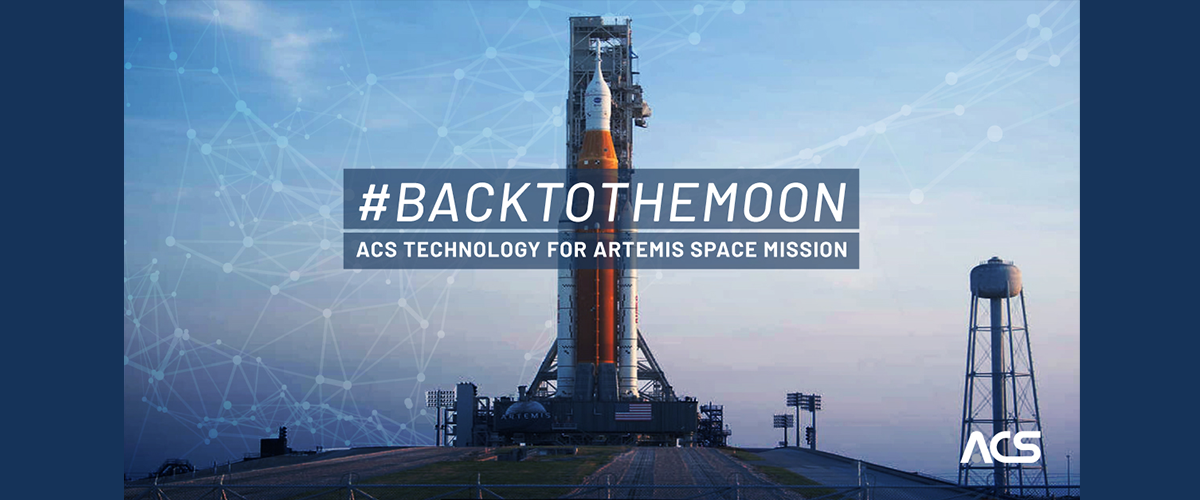
ACS contribution to the Artemis space mission
The ArgoMoon nanosatellite on board the Space Launch System - on its way to the Moon - was made by the Italian company Argotec and tested by an ACS space simulator.
ACS technology has made an important contribution to the Artemis mission, which aims to return astronauts to the lunar surface, ushering in an exciting new era of space exploration.
One of our thermal vacuum chambers played a crucial role in the delicate testing phases of the only European CubeSat on board the lunar super rocket. The CubeSat ArgoMoon, a small satellite that will have the task of photographing the second stage of the rocket, is produced by the Turin-based company Argotec, which is increasingly renowned thanks to its numerous valuable aerospace projects, such as LICIACube, another microsatellite that recently undertook a journey 11 million kilometres from Earth and actively participated in NASA's first planetary defence mission, DART (Double Asteroid Redirection Test).
The Artemis mission involves various companies, Research Centres and Space Agencies: among them, also numerous long-standing customers of Angelantoni Test Technologies, including the manufacturers of some components of the Orion capsule's ESM (European Service Module).
The ArgoMoon nanosatellite tested in an ACS Thermal Vacuum Chamber
Travelling with Artemis I will be 10 CubeSats, small satellites that will conduct science and technology demonstration activities in lunar orbit. Positioned above the rocket's second stage, they will be released according to a precise schedule a few hours after lift-off.
The only European among the 10 nanosatellites is called ArgoMoon and is a CubeSat of the Italian Space Agency built by the Turin-based company Argotec. ArgoMoon will have an important task: it will provide NASA with all the images needed to confirm the correct operation of the SLS launcher, which will not be able to send signals towards Earth when the CubeSat is released.
The Italian company Argotec is using a small ACS space simulator in its testing facility: the 'exceptional space observer' nanosatellite has therefore been validated using ACS technology.
Watch the video: at min 1:00 also a timelapse with the insertion of the specimen into the ACS Thermal Vacuum Chamber.
The European Service Module (ESM) of the Orion capsule
Even numerous technologies of strategic importance for the construction of the Orion capsule's ESM are made by companies using ACS products for the fundamental testing phase.
A few examples:
- Thales Alenia Space was responsible for building the structure of the ESM module and critical subsystems - including the system for protection against micrometeorites and thermal control; it is also responsible for building the components for the Lunar Gateway: I-HAB, the international habitation module; ESPRIT, the communications and refuelling module; and finally, the primary structure of HALO, the habitation and logistics module.
- To Leonardo, the task of building the photovoltaic panels (PVA) that compose the four 'wings' of the service module and the electronic units (PCDU) that provide control and power distribution to the spacecraft.
The Artemis space exploration programme
It was named Artemis, after the goddess in Greek mythology who was Apollo's twin sister. The very Apollo that had inspired the name of the first famous missions to the Moon. In December 1972, the last Apollo 17 mission saw geologist Harrison Schmitt and commander Eugene Cernan on the Moon. Almost 50 years later, the ambitious project foresees a new lunar landing with a six-day stay on the ground of our satellite for two more astronauts, a man and a woman. And it doesn't end here: the next step will be to test the technologies needed to fly human missions to Mars.
The space exploration programme will consist of three main stages:
Artemis I. The unmanned test flight, which was scheduled to be launched on 29 August 2022, was postponed due to a malfunction of one of the four engines of the giant SLS rocket. One of its purposes is to test the actual functioning of the launch system intended to put the Orion spacecraft, the module that will later carry the astronauts, into orbit.
In addition, Orion's systems in the space flight environment and the re-entry process, i.e. the safe descent, splashdown and recovery in anticipation of the first manned flight on Artemis II, will be tested.
With Artemis I, Orion will spend 42 days in space, orbit the Moon and return to Earth by landing off the coast of San Diego. The launch will take place from the same site as the Apollo missions, from the Kennedy Space Center at Cape Canaveral.
Artemis II. It will be the first flight test with the crew on board and will be used to demonstrate that Orion's systems are ready to support the astronauts on long-term missions. The astronauts will have the opportunity to practise the operations that will then be essential for the success of the third phase.
Artemis III. Scheduled for 2025, this will be the mission that will represent humanity's return to the surface of the Moon.
The crucial elements of the Artemis programme include the Space Launch System (SLS), the Orion spacecraft for transporting astronauts, the Lunar Gateway, the astronauts' orbiting home around the Moon, and the lunar landing system.
The space exploration mission is led by NASA in collaboration with ESA (European Space Agency), plus the Japan Aerospace Exploration Agency (JAXA) and the Canadian Space Agency (CSA).